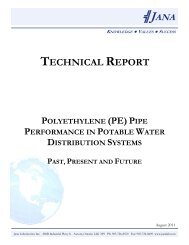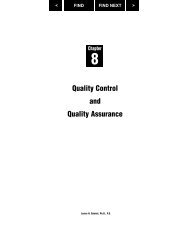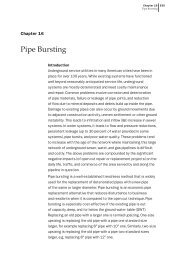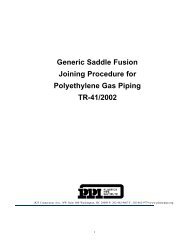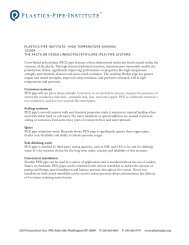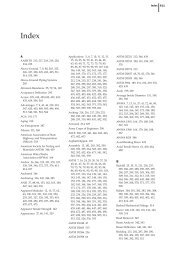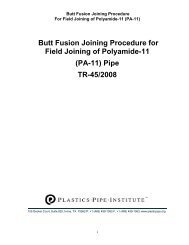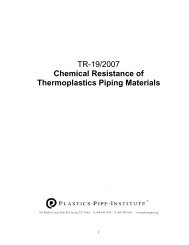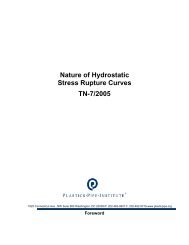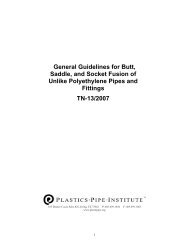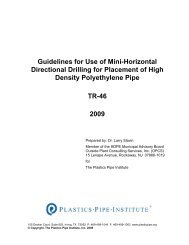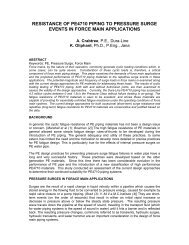TR-34: Disinfection of Newly Constructed Polyethylene Water Mains
TR-34: Disinfection of Newly Constructed Polyethylene Water Mains
TR-34: Disinfection of Newly Constructed Polyethylene Water Mains
You also want an ePaper? Increase the reach of your titles
YUMPU automatically turns print PDFs into web optimized ePapers that Google loves.
Effects <strong>of</strong> <strong>Disinfection</strong> on <strong>Newly</strong><br />
<strong>Constructed</strong> <strong>Polyethylene</strong><br />
<strong>Water</strong> <strong>Mains</strong><br />
<strong>TR</strong>-<strong>34</strong> / 2001 B<br />
Plastics Pipe Institute<br />
www.plasticpipe.org<br />
1
Foreword<br />
This report was developed and published with the technical help and financial<br />
support <strong>of</strong> the members <strong>of</strong> Plastics Pipe Institute, PPI. The members have shown<br />
their interest in quality products by assisting independent standards-making and<br />
user organizations in the development <strong>of</strong> standards, and also by developing<br />
reports on an industry-wide basis to help engineers, code <strong>of</strong>ficials, specifying<br />
groups, and users.<br />
The intent <strong>of</strong> this technical report is to provide information on the effects <strong>of</strong><br />
chlorine disinfection on the durability <strong>of</strong> PE piping for water systems. The testing<br />
reported herein was conducted on service pipe sizes and on resins in the form <strong>of</strong><br />
plaques in accordance with the various test methods employed. At the time the<br />
testing was conducted, high performance PE materials such as PE4710 were not<br />
available. In 2006, PPI established a new program to provide test information on<br />
high performance PE materials, and will update this report when the information<br />
is available.<br />
Tests on piping in this report were conducted on service sizes; however, larger<br />
PE pipes produced to AWWA C901 and AWWA C906 are subject to the identical<br />
water service design criteria and in-service operating stresses. Furthermore,<br />
chlorine resistance tests <strong>of</strong> other olefin materials such as PEX have<br />
demonstrated that tests <strong>of</strong> service sizes are representative <strong>of</strong> larger sizes.<br />
Therefore, the test results herein are expected to be representative <strong>of</strong> larger<br />
sizes.<br />
This report has been prepared by PPI as a service <strong>of</strong> the industry. The<br />
information in this report is <strong>of</strong>fered in good faith and believed to be accurate at<br />
the time <strong>of</strong> its preparation, but is <strong>of</strong>fered without any warranty, expressed or<br />
implied, including WARRANTIES OF MERCHANTABILITY AND FITNESS FOR<br />
A PARTICULAR PURPOSE. Any reference to or testing <strong>of</strong> a particular<br />
proprietary product should not be construed as an endorsement by PPI, which<br />
does not endorse the proprietary products or processes <strong>of</strong> any manufacturer.<br />
The information in this report is <strong>of</strong>fered for consideration by industry members in<br />
fulfilling their own compliance responsibilities. PPI assumes no responsibility for<br />
compliance with applicable laws and regulations.<br />
PPI intends to revise this report from time to time, in response to comments and<br />
suggestions from users <strong>of</strong> the report. Please send suggestions <strong>of</strong> improvements<br />
to the address below. Information on other publications can be obtained by<br />
contacting PPI directly or visiting the web site.<br />
The Plastics Pipe Institute<br />
http://www.plasticpipe.org<br />
(Editorial Revisions, February 2007)<br />
2
Effects <strong>of</strong> <strong>Disinfection</strong> on <strong>Newly</strong><br />
<strong>Constructed</strong><br />
<strong>Polyethylene</strong> <strong>Water</strong> <strong>Mains</strong><br />
Table <strong>of</strong> Contents<br />
1. Introduction 4<br />
2. Scope 4<br />
3. Methods <strong>of</strong> Chlorination 4<br />
4. Industry Practice 5<br />
5. Test Results 5<br />
5.1 Quick Burst 5<br />
5.2 Sustained Hydrostatic Burst 7<br />
5.3 Tensile and Elongation 9<br />
5.4 Oxidative Induction Time 9<br />
5.5 High Speed Tensile Impact 10<br />
5.6 PENT Testing 11<br />
6. Other Experience 12<br />
7. Chlorine Dissipation Rate 13<br />
8. Conclusions / Recommendations 13<br />
9. References 13<br />
3
1. Introduction<br />
Disinfecting <strong>of</strong> water mains has been a common industry practice for many<br />
years. The first AWWA standard covering this practice was approved in<br />
September 1947 (as 7D.2-1948). In 1986, the designation <strong>of</strong> the standard was<br />
changed to AWWAC651; the latest revision is ANSI/ AWWA-C651-92. The<br />
standard describes methods <strong>of</strong> disinfecting newly constructed potable water<br />
mains; mains that have been removed from service for planned repairs or for<br />
maintenance that exposes them to contamination; mains that have undergone<br />
emergency repairs due to physical failure; and mains that, under normal<br />
operation, continue to show the presence <strong>of</strong> coliform organisms.<br />
Because the chlorine disinfection process puts pipe in contact with a strong<br />
oxidizer, a task group was formed in June 1993, within the PPI Technical<br />
Committee to investigate possible effects <strong>of</strong> disinfection on the durability <strong>of</strong> PE<br />
piping in potable water service. While C651 covers all piping materials used in<br />
potable water service, this investigation was confined to polyethylene systems.<br />
Chlorine was the only disinfecting agent investigated; chloramines were not<br />
evaluated. All tests conducted were short term, run at ambient temperature<br />
conditions on pipe samples made from particular polyethylene pipe compounds.<br />
The report is not to be construed as an indicator <strong>of</strong> the long-term performance <strong>of</strong><br />
polyethylene pipe in general, or in the specific user’s environment and operating<br />
conditions.<br />
2. Scope<br />
At the first task group meeting, the following scope was adopted: To investigate<br />
and quantify, if possible, any effects on the durability <strong>of</strong> PE piping caused by<br />
disinfection per AWWA C651. Exposure times and concentration levels were<br />
chosen to be consistent with the requirements <strong>of</strong> the standard. Note that the<br />
disinfection practices outside the constraints used in this study (i.e., exposure<br />
time, etc.) may yield different results - e.g., if a contractor leaves a pipe full <strong>of</strong><br />
concentrated disinfectant for 6 months.<br />
3. Methods <strong>of</strong> Chlorination<br />
Three methods <strong>of</strong> chlorination are explained in AWWA-C651: tablet, continuous<br />
feed, and slug. The tablet method is intended to give an average chlorine dose <strong>of</strong><br />
approximately 25 mg/L, and precautions shall be taken to ensure that air pockets<br />
are eliminated and the water shall remain in the pipe for at least 24 hours. If the<br />
water temperature is less than 41°F (5°C), the water shall remain in the pipe for<br />
at least 48 hours ; the continuous feed to give a 24 hour residual <strong>of</strong> not less than<br />
10 mg/ L; and the slug method to give a 3 hour exposure <strong>of</strong> not less than 50<br />
mg/L free chlorine. .. Residual free chlorine In the slug method, shall be<br />
measured as it moves through the main. If at any time it drops below 50 mg/ L,<br />
the flow shall be stopped, chlorination equipment shall be relocated at the head<br />
4
<strong>of</strong> the slug, and, as flow is resumed, chlorine shall be applied to restore the free<br />
chlorine in the slug to not less than 100 mg/ L.<br />
4. Industry Practice<br />
To compare actual industry practice with AWWA C651 recommendations, a task<br />
group member conducted an informal survey <strong>of</strong> numerous City <strong>Water</strong><br />
Departments. The survey was geographically broad and included utilities in<br />
Seattle (WA), Fresno (CA), Chicago (IL), Minneapolis (MN), San Antonio (TX),<br />
Savannah (GA) and Augusta (ME). It was learned that chlorine was by far the<br />
disinfectant <strong>of</strong> choice. All three methods described in C651 (tablet, continuous<br />
feed, and slug) are used, with the tablet method being the most popular because<br />
it requires no additional equipment.<br />
For the tablet method, AWWA C-651 recommends the use <strong>of</strong> an average<br />
chlorine content <strong>of</strong> 25 mg/L for at least 24 hours. The utilities surveyed stated<br />
that concentrations ranging from 25-150 mg/L were used for durations from 24 to<br />
72 hours. Preferably, disinfection should be carried out overnight, however, not<br />
on a day before the weekend or holidays<br />
In the continuous feed method, the chlorine may be added as dissolved calcium<br />
hypochlorite, sodium hypochlorite, liquid chlorine or dissolved chlorine gas.<br />
Several opinions were given that dissolved chlorine gas <strong>of</strong>fered the “best”<br />
disinfection; however, environmental concerns and regulations have made this<br />
option less desirable. The water utilities that were interviewed use concentrations<br />
ranging from 25-60 mg/ L for durations <strong>of</strong> 24-72 hours.<br />
The slug method is generally used in conjunction with the tablet method. After<br />
the tablet method is completed and flushed, a heavily concentrated slug <strong>of</strong><br />
chlorine is added to the main and slowly forced through the system. The<br />
concentration <strong>of</strong> the slug is monitored and more chlorine is added if the free<br />
chlorine residual drops below 50 mg/ L. Several <strong>of</strong> the utilities use this method at<br />
concentrations <strong>of</strong> 300-500 mg/L. Disposal and treatment <strong>of</strong> the heavily<br />
chlorinated water can become a problem with this procedure.<br />
5. Test Results<br />
To evaluate the effects <strong>of</strong> chlorine exposure on PE water pipe during typical<br />
disinfection, physical properties <strong>of</strong> selected PE pipe samples were studied.<br />
Properties <strong>of</strong> pipe specimens exposed to chlorine were compared to properties <strong>of</strong><br />
the same specimens that were not exposed. The test methods and the results <strong>of</strong><br />
these tests are presented herein.<br />
5.1 Quick Burst<br />
Test Objective: To determine if the chlorine exposure had a detrimental effect on<br />
the burst strength <strong>of</strong> the pipe. Testing was conducted on pipe specimens filled<br />
5
with a 185-ppm chlorine water solution and conditioned for 72 hours at room<br />
temperature. Control specimens were also tested. The controls were not filled<br />
with tap water until tested.<br />
Test Method: Quick burst testing was then conducted in accordance with ASTM<br />
D-1599, Standard Test Method for Short-Time Hydraulic Failure Pressure <strong>of</strong><br />
Plastic Pipe, Tubing, and Fittings. Several specimens were prepared from each<br />
sample. The specimens were 18” in length and sealed at each end with<br />
Swagelok fittings. For each sample, half the specimens were filled with water<br />
containing chlorine at 185 ppm, the other half were not filled until testing. The<br />
specimens exposed to chlorine were then placed on a sealed manifold for 72<br />
hours. The control specimens were conditioned in the same room as the chlorine<br />
specimens for the same time period.<br />
Description <strong>of</strong> Test Samples:<br />
• 1: ½” SIDR 11.5 PE2306, ASTM D2239<br />
• 2: ½” SIDR 11.5 PE<strong>34</strong>08, AWWA C901<br />
• 3: ¾” SDR 9 PE<strong>34</strong>06, ASTM D2737<br />
• 4: ¾” SDR 9 PE<strong>34</strong>08, ASTM D2737<br />
• 5: ¾: SDR 9 PE <strong>34</strong>08, ASTM D2737<br />
Test Results and Data:<br />
Burst Pressures, psi<br />
Sample Without Chlorine With Chlorine<br />
1<br />
545 530<br />
510 530<br />
610 600<br />
2<br />
600 590<br />
620 610<br />
800 960<br />
3<br />
800 810<br />
810 830<br />
1040 1030<br />
4<br />
990 960<br />
960 990<br />
5<br />
850 830<br />
840 850<br />
6
Failures for samples 2, 3, 4 and the chlorine specimens <strong>of</strong> sample 5 were in a<br />
ductile mode with ballooning prior to rupture. Failures for samples 1 and the nonchlorine<br />
specimens <strong>of</strong> sample 5 were in the slit mode.<br />
Conclusion: The burst strength <strong>of</strong> <strong>Polyethylene</strong> (PE) pipe exposed to 185 mg/L<br />
chlorine for 72 h, showed no apparent difference from that filled with tap water.<br />
5.2 Sustained Hydrostatic Burst<br />
To further evaluate the possible effects <strong>of</strong> chlorine exposure on actual pipe<br />
samples, sustained pressure testing per ASTM-D1598, Standard Test Method for<br />
Time-to-Failure <strong>of</strong> Plastic Pipe Under Constant Internal Pressure, was conducted<br />
on samples <strong>of</strong> the PE<strong>34</strong>08 pipe. Testing was performed at 176°F to accelerate<br />
any adverse effects on performance. Two different conditioning times were used:<br />
72 hours and 240 hours. Further details <strong>of</strong> the test and results are listed below.<br />
Set 1<br />
Conditioning:<br />
72 hours<br />
73+3°F<br />
321 mg/ L free chlorine at start <strong>of</strong> conditioning<br />
Control samples were not exposed to any chlorine during conditioning<br />
Testing:<br />
176+3°F<br />
Specimen Hoop Stress Conditioning Failure<br />
1 600 psi Chlorine 916 hr (no failure)<br />
2 600 psi Control 916 hr (no failure)<br />
3 600 psi Chlorine 916 hr (no failure)<br />
4 600 psi Control 916 hr (no failure)<br />
5 600 psi Chlorine 916 hr (no failure)<br />
6 600 psi Control 916 hr (no failure)<br />
7 750 psi Chlorine 953 hr (no failure)<br />
8 750 psi Control 953 hr (no failure)<br />
9 750 psi Chlorine 953 hr (no failure)<br />
10 750 psi Control 953 hr (no failure)<br />
11 750 psi Chlorine 953 hr (no failure)<br />
12 750 psi Control 953 hr (no failure)<br />
7
Set 2<br />
Conditioning:<br />
240 hours<br />
73+3°F<br />
305 mg/ L free chlorine at start <strong>of</strong> conditioning:<br />
210 mg/L at 120 hrs, refilled;<br />
309 mg/ L at refilled (120 hrs);<br />
217 mg/ L at 240 hrs<br />
Control samples were not exposed to any chlorine during conditioning<br />
Testing:<br />
176+3°F<br />
Specimen Hoop Stress Conditioning Failure<br />
1 600 psi Chlorine 420 hr (no failure)<br />
2 600 psi Control 420 hr (no failure)<br />
3 600 psi Chlorine 420 hr (no failure)<br />
4 600 psi Control 420 hr (no failure)<br />
5 600 psi Chlorine 420 hr (no failure)<br />
6 600 psi Control 420 hr (no failure)<br />
7 750 psi Chlorine 446 hr (no failure)<br />
8 750 psi Control 446 hr (no failure)<br />
9 750 psi Chlorine 446 hr (no failure)<br />
10 750 psi Control 446 hr (no failure)<br />
11 750 psi Chlorine 446 hr (no failure)<br />
12 750 psi Control 446 hr (no failure)<br />
Although somewhat limited, the results <strong>of</strong> sustained hydrostatic burst testing do<br />
not suggest any significant effect <strong>of</strong> chlorine exposure on long term performance.<br />
Unfortunately, testing could not be continued longer because <strong>of</strong> the need for the<br />
test stations being used. Ideally, data at sufficient pressures and times to permit<br />
calculation <strong>of</strong> Hydrostatic Design Basis would provide a better estimate <strong>of</strong> long<br />
term performance.<br />
It should be noted that all <strong>of</strong> the specifications for polyethylene water pipe (ASTM<br />
D2239, D3035, D2447, etc.) contain a sustained pressure requirement. The highdensity<br />
material used for this study would be required to pass a 176°F sustained<br />
pressure test <strong>of</strong> 60 hours (minimum) at 725 psi or 150 hours (minimum) at 580<br />
psi. It can be seen that all <strong>of</strong> the samples used in this study easily met these<br />
requirements.<br />
8
5.3 Tensile and Elongation<br />
A standard PE <strong>34</strong>08 resin was compression molded in accordance with<br />
Procedure C <strong>of</strong> ASTM Method D1928. The molded specimens were randomly<br />
divided into two groups. One group was placed in a glass vessel containing a<br />
200-ppm chlorine water solution at room temperature. Measurements <strong>of</strong> free<br />
chlorine were made every other day and sodium chlorite solution added to<br />
maintain the 200-ppm target. The second group <strong>of</strong> specimens was exposed to<br />
“tap water” with a measured chlorine content <strong>of</strong> approximately 1 ppm. Samples<br />
were then removed periodically from the vessel and tested for tensile strength at<br />
yield and elongation at break in accordance with ASTM D638. A grip separation<br />
rate <strong>of</strong> 2-in/ minute was used. It should be noted that, because <strong>of</strong> the large<br />
number <strong>of</strong> samples required, only two specimens were tested at each <strong>of</strong> the time<br />
periods noted. This undoubtedly contributed to the scatter seen in the results.<br />
Based on the early test results, exposure times were extended well beyond the<br />
original intent in an attempt to detect any possible downward trend. Exposure<br />
testing was carried out to 1176 hours without any indications <strong>of</strong> adverse effects.<br />
Test results are summarized below:<br />
Hours<br />
Tensile Strength (Break) (Elongation Break)<br />
Chlorine <strong>Water</strong> Chlorine <strong>Water</strong><br />
24 4210 805<br />
48 4141 796<br />
72 4180 748<br />
168 4285 4262 760 762<br />
336 4249 4484 731 779<br />
504 4314 4902 730 756<br />
672 4753 805<br />
840 4125 4329 793 752<br />
972 4107 721<br />
1008 4272 3990 781 788<br />
1176 4310 803<br />
5.4 Oxidative Induction Time<br />
Because the chlorine disinfection process puts polyethylene pipe in contact with<br />
a strong oxidizer, it was decided to monitor the effect on chlorine exposure on<br />
thermal stability. Oxidative Induction Time as measured by a differential scanning<br />
colorimeter (DSC) was used as an indication <strong>of</strong> thermal stability. The same<br />
compression molded samples (PE<strong>34</strong>08) and chlorine solution (200 ppm) used for<br />
tensile strength and elongation measurements in Section 5.4 were used in this<br />
9
study. Again, exposure times were extended well beyond the original intent in an<br />
attempt to detect any possible downward trend. Exposure time and OIT results<br />
are summarized below:<br />
Hours<br />
OIT, minutes<br />
Chlorine<br />
<strong>Water</strong><br />
24 17.2 17.2<br />
48 18.8 17.9<br />
72 16.2 16.8<br />
168 18.8 19.2<br />
336 19.9 20.1<br />
504 16.3 16.6<br />
672 19.5 20.1<br />
840 19.0 20.2<br />
1008 17.8 16.9<br />
1176 17.4 16.4<br />
1512 17.9 17.5<br />
1872 18.2 17.9<br />
2400 18.4 17.6<br />
2568 17.9 17.6<br />
It is apparent that no downward trend is evident even after 2,500 hours <strong>of</strong><br />
exposure. Although some variation in the individual measurements is visible,<br />
there does not appear to be a significant difference between the chlorine and<br />
water exposures.<br />
5.5 High Speed Tensile Impact<br />
A new high-speed tensile impact test (the McSnapper) has been gaining<br />
increased popularity in the industry to evaluate the integrity <strong>of</strong> heat fusion joints.<br />
It was believed that the test might be sensitive enough to detect any adverse<br />
effect <strong>of</strong> chlorine exposure on the fusion joint. Two samples <strong>of</strong> PE<strong>34</strong>08 pipe were<br />
prepared by heat fusing two segments each together. One sample was capped,<br />
filled with tap water and stored at room temperature (75°F) for 30 days. The other<br />
sample was capped, filled with 200-ppm chlorine water and stored for 72 hours.<br />
No internal pressure was applied to either sample at the end <strong>of</strong> the exposure<br />
periods; the samples were drained and flushed with distilled water.<br />
10
Four sample coupons were cut from each sample. The results <strong>of</strong> measuring high<br />
speed tensile with impact device are summarized below.<br />
Energy, in-lbf<br />
Sample Number <strong>Water</strong> Chlorine<br />
1 240.6 247.6<br />
2 256.8 273.8<br />
3 300.3 211.3<br />
4 260.0 305.5<br />
It was concluded that there was no appreciable difference in tensile strength<br />
between the two samples.<br />
5.6 PENT Testing<br />
One <strong>of</strong> the major concerns for long term performance <strong>of</strong> polyethylene pipe (for<br />
both water and gas) continues to be its resistance to slow crack growth. Although<br />
the standard method for determining Hydrostatic Design Basis (ASTMD2837)<br />
has provided an excellent estimate <strong>of</strong> this parameter; it is admittedly a lengthy<br />
and labor intensive procedure. Over the years, a number <strong>of</strong> tests have been<br />
developed to provide an accelerated estimate <strong>of</strong> resistance to slow crack growth.<br />
These include Test Method for Environmental Stress-Cracking <strong>of</strong> Ethylene<br />
Plastics (D1693) and Test Method for Determination <strong>of</strong> Environmental Stress<br />
Crack Resistance (ESCR) <strong>of</strong> <strong>Polyethylene</strong> Pipe (F1248). However, as<br />
polyethylene materials have improved over the years, the time to failure using<br />
these ESCR tests has increased dramatically. In the continuing search for a<br />
quicker slow crack growth test, two more recent tests have emerged. One is the<br />
PENT Test that is <strong>of</strong>ficially designated as ASTM F1473 - Standard Test Method<br />
for Notch Tensile Test to Measure the Resistance to Slow Crack Growth <strong>of</strong><br />
<strong>Polyethylene</strong> Pipes and Resins. The other is the British Gas Notch Test which<br />
has been adopted by ISO as FDIS 1<strong>34</strong>79-<strong>Polyethylene</strong> Pipes for the<br />
Conveyance <strong>of</strong> Fluids-Determination <strong>of</strong> Resistance to Crack Propagation Test<br />
Method for Slow Crack Growth on Notched Pipes (notch test). It has also been<br />
added to ASTM as F1474. Both <strong>of</strong> these tests have demonstrated promise in<br />
predicting resistance to slow crack growth in a reasonable time frame.<br />
It has become apparent that the European/ World community has selected the<br />
notched pipe test to measure resistance to slow crack growth while the U.S. pipe<br />
industry has selected the PENT Test. A number <strong>of</strong> Task Groups have been<br />
formed in both PPI and ASTM to refine the test method and to build a data base<br />
for establishing acceptance values for the various end use applications. For<br />
those reasons, a standard PE <strong>34</strong>08 pipe material was compression molded and<br />
milled to size following the procedure outlined in ASTM F1474. A total <strong>of</strong> six<br />
specimens were prepared from the same resin sample. Two were notched and<br />
used as the control; two were exposed to 200-ppm chlorine water and then<br />
11
notched. The third set were notched and then exposed to 200-ppm chlorine<br />
water. Constant Tensile Load testing at 80° (PENT Test) was then performed.<br />
Results are summarized below:<br />
Control<br />
72 hr Cl, then notched<br />
Notched, then 72 hr Cl<br />
PENT Values, hr<br />
68.36<br />
70.44<br />
65.44<br />
70.61<br />
68.82<br />
68.27<br />
PENT Average, hr.<br />
69.40<br />
68.03<br />
67.72<br />
All <strong>of</strong> the above values would be considered to be within the accuracy <strong>of</strong> the test<br />
method. Chlorine exposure did not appear to adversely affect test life <strong>of</strong> the PE<br />
resin.<br />
6. Other Experience<br />
Studsvik Material AB in Sweden has done a number <strong>of</strong> studies on the long-term<br />
behavior <strong>of</strong> polyolefin pipes used in hot water environments. One - “Long-Term<br />
Properties <strong>of</strong> Hot-<strong>Water</strong> Polyolefin Pipes - A Review “ by U.W. Gedde, J. Viebke,<br />
H. Leijstrom and M. Ifwarson is <strong>of</strong> particular interest. A collective view <strong>of</strong> the<br />
changes in antioxidant concentration pr<strong>of</strong>iles and molecular/ physical structure<br />
accompanying hot-water exposure is presented. A presentation is also made <strong>of</strong><br />
current lifetime extrapolation methods. Studsvik performs long-term hydrostatic<br />
burst testing using chlorine for clients on a proprietary basis.<br />
The effect <strong>of</strong> chlorine on PE piping in water distribution service has been a<br />
concern in Japan for many years. However, the major part <strong>of</strong> their investigations<br />
has been with piping made from lower density PE materials and used in water<br />
distribution. A test method on blistering caused by chlorine contact has been<br />
written and acceptance levels for the degree <strong>of</strong> blistering have been established.<br />
12
7. Chlorine Dissipation Rate<br />
To estimate the dissipation rate <strong>of</strong> chlorine, without the addition <strong>of</strong> fresh chlorine,<br />
seven pipe samples were filled with water originally at 321-mg/ L free chlorine.<br />
The samples were then capped with mechanical steel fittings and sealed. At<br />
each <strong>of</strong> the times shown below, one sample was opened and the water<br />
immediately analyzed for free chlorine.<br />
Start<br />
321 mg/L<br />
24 hours 271 mg/L<br />
48 hours 227 mg/L<br />
72 hours 216 mg/L<br />
96 hours 168 mg/L<br />
8 days 140 mg/L<br />
14 days 58 mg/L<br />
8. Conclusions/ Recommendations<br />
The testing performed in this study indicates that chlorine disinfection, when<br />
conducted within the guidelines <strong>of</strong> AWWA-C651, does not have a significant<br />
adverse affect on the performance <strong>of</strong> PE pipe. No indications <strong>of</strong> any downward<br />
trends in the exposure tests were evident.<br />
9. References<br />
ASTM D-1599, Standard Test Method for Short-Time Failure Pressure <strong>of</strong> Plastic<br />
Pipe, Tubing and Fittings.<br />
ASTM D-1598, Standard Test Method for Time-to-Failure <strong>of</strong> Plastic Pipe Under<br />
Constant Internal Pressure.<br />
ASTM D-638, Test Method for Tensile Properties <strong>of</strong> Plastics<br />
ASTM D-2837, Test Method for Obtaining Hydrostatic Design Basis for<br />
Thermoplastic Pipe Materials.<br />
ASTM D-1693 Stress-Cracking <strong>of</strong> Ethylene Plastics<br />
ASTM F-1248, Test Method for Determination <strong>of</strong> Environmental Stress Crack<br />
Resistance (ESCR) <strong>of</strong> <strong>Polyethylene</strong> Pipe.<br />
ASTM F-1473, Standard Test Method for Notch Tensile Test to Measure the<br />
Resistance to Slow Crack Growth <strong>of</strong> <strong>Polyethylene</strong> Pipes and Resins.<br />
13
AWWA C-651, Disinfecting <strong>Water</strong> <strong>Mains</strong><br />
AWWA C-901, <strong>Polyethylene</strong> (PE) Pressure Pipe and Tubing, ½ in Through 3<br />
inch, for <strong>Water</strong> Service<br />
AWWA C–906, <strong>Polyethylene</strong> (PE) Pressure Pipe and Fittings, 4 in. (100 mm)<br />
through 63 in. (1,575 mm), for <strong>Water</strong> Distribution and Transmission<br />
ISO FDIS-1<strong>34</strong>79, <strong>Polyethylene</strong> Pipes for the Conveyance <strong>of</strong> Fluids -<br />
Determination <strong>of</strong> Resistance to Crack Propagation Test Method for Slow Crack<br />
Growth on Notched Pipes<br />
U.W. Gedde, J. Viebke, H. Leijstrom and M. Ifwarson, Polymer Engineering and<br />
Science, <strong>34</strong>, 24 (1994).<br />
14




